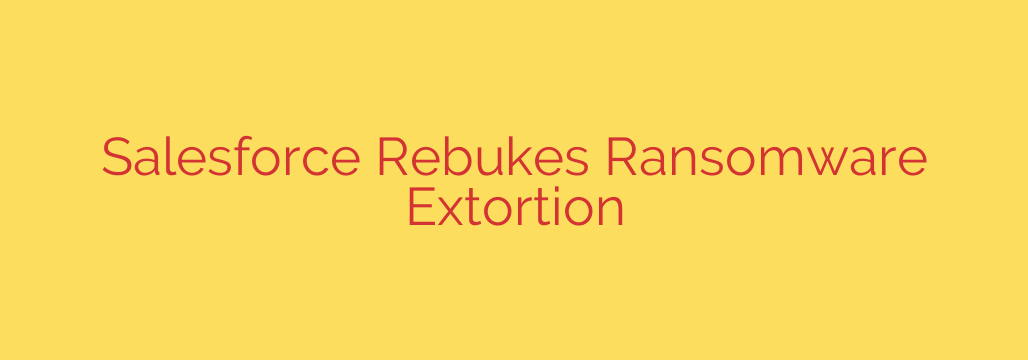
Salesforce Takes a Hard Line on Ransomware: What Businesses Need to Know
In the complex world of cybersecurity, the actions of major tech leaders can set a powerful precedent. Recently, businesses have been closely watching the response to a significant security event involving customer data, and the message being sent is clear: do not negotiate with cybercriminals.
This situation stems from a security incident not within a company’s own network, but from a third-party vendor—a stark reminder of the interconnected nature of modern digital infrastructure. Threat actors who successfully breached a third-party platform have been using stolen data to extort customers, creating confusion and fear. In response, a firm and unwavering stance has been taken against paying these extortion demands.
Here’s a breakdown of the situation and the critical lessons for every organization.
Understanding the Threat: The Rise of Supply Chain Attacks
The core of this incident is a supply chain attack. This is when malicious actors gain access to a company’s data not by breaching its own defenses, but by targeting a weaker link in its network of partners, suppliers, or software vendors.
In this case, the key points are:
- A third-party vendor was compromised, leading to the exfiltration of data belonging to the customers of a larger platform.
- The primary platform’s core systems and services remained secure and were not breached directly.
- The ransomware gang is now leveraging the stolen data to directly threaten and extort the affected customers, demanding payment to prevent the public release of their information.
This tactic, known as data extortion, is increasingly popular among cybercriminal groups. Instead of just encrypting your files, they steal them and use the threat of exposure as leverage.
The Official Stance: Why Paying the Ransom is a Mistake
The guidance issued to affected customers has been direct and unequivocal: do not pay the ransom. This advice is rooted in years of experience from cybersecurity experts and law enforcement agencies who have seen how these scenarios play out.
There are several critical reasons why paying a ransom is a dangerous and ineffective strategy:
- There is no guarantee of data deletion. You are dealing with criminals who have no incentive to honor their word. Many organizations that pay ransoms find their data leaked anyway or are targeted for a second payment demand.
- Paying funds future criminal activity. Every ransom paid provides cybercriminal gangs with more resources to refine their tools, scale their operations, and attack more victims. It directly contributes to the growth of the ransomware ecosystem.
- It marks you as a willing target. Companies that pay are often added to a list of “willing payers,” making them more likely to be targeted again in the future by the same group or others.
- It complicates legal and recovery efforts. Cooperating with law enforcement is crucial for tracking and dismantling these criminal networks. Paying a ransom can undermine these official investigations.
Instead of capitulating, the recommended course of action is to work closely with security teams and law enforcement to manage the incident.
Actionable Security Tips for Your Business
This incident serves as a vital learning opportunity for all businesses, regardless of size. To protect your organization from similar threats, it’s essential to adopt a proactive security posture.
Here are four key steps you can take today:
Strengthen Your Credential Security: The vast majority of breaches begin with compromised credentials. Enforce multi-factor authentication (MFA) across all critical systems, including email, VPNs, and cloud services. Educate your team on creating strong, unique passwords and the dangers of phishing attacks.
Conduct Rigorous Third-Party Vendor Reviews: Your security is only as strong as your weakest link. Before partnering with any vendor that will handle your data, perform a thorough security assessment. Ask about their data protection policies, breach notification procedures, and security certifications. Your partners’ security posture is an extension of your own.
Develop and Test an Incident Response Plan: Don’t wait for a crisis to figure out what to do. A well-documented incident response plan ensures your team can act quickly and effectively to contain a threat, assess the damage, and communicate with stakeholders. This plan should clearly state your organization’s policy on paying ransoms.
Prioritize Data Backups: While this incident focuses on data extortion rather than encryption, having secure, offline backups is a cornerstone of cyber resilience. Regularly back up critical data and test your restoration process to ensure you can recover quickly from any data loss event, whether it’s a ransomware attack, hardware failure, or human error.
Ultimately, the fight against ransomware requires a united front. By refusing to pay ransoms, strengthening defenses, and sharing information, the business community can make cybercrime less profitable and protect the entire digital ecosystem.
Source: https://go.theregister.com/feed/www.theregister.com/2025/10/08/salesforce_refuses_to_pay_ransomware/








